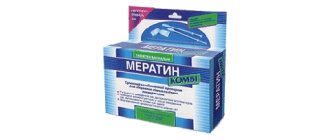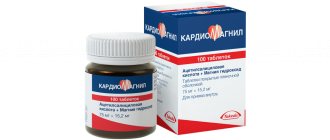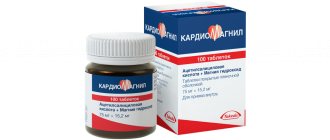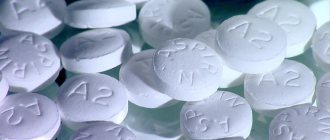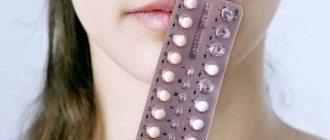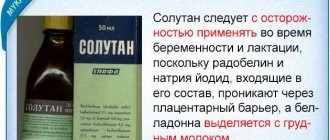Pharmacodynamics and pharmacokinetics
Pharmacodynamics
The drug Quinidine belongs to class IA antiarrhythmic drugs . Inhibits the transfer of sodium ions through fast channels of the cell wall of cardiomyocytes, reduces the maximum rate of depolarization, increases the duration of the action potential and the effective refractory period of time. Reduces myocardial excitability, conductivity and automaticity in the AV node, atria, His bundle and other structures. It has a vagolytic effect, reduces the contractile activity of the heart, can cause a decrease in blood pressure, and also has an m-anticholinergic effect.
The negative inotropic effect is the result of inhibition of energy conversion in mitochondria. The antiarrhythmic effect is caused by the presence of an amide group in the structure of the molecule. The decrease in the speed of propagation of excitation is associated with an effect on the depolarization process. Suppression of conduction is manifested on the ECG by an increase in the QRS segment, inhibition of repolarization is expressed in an increase in the QT segment. In toxic dosages, the drug Quinidine enhances the automaticity function of Purkinje fibers.
By suppressing m-cholinergic receptors, it stimulates AV conduction. In therapeutic doses it has a hypotensive effect due to a decrease in the tone of peripheral arteries and veins and a negative inotropic effect. Demonstrates local irritating effect. It also has analgesic and antipyretic effects, which is associated with a depressant effect on the brain.
Pharmacokinetics
After oral administration, the highest concentration of the drug in the blood is achieved after an hour and a half. Reaction with proteins is 75-80%. Biotransformed in the liver. Some derivatives have a cardiotonic effect. The half-life is approximately 6 hours. It is evacuated mainly by the kidneys. The release of the drug increases when the urine becomes acidic and is inhibited when it is alkaline.
Quinidine is a class IA antiarrhythmic used for the treatment of supraventricular and ventricular extrasystoles, atrial tachycardia, AV tachycardia, paroxysmal fibrillation and atrial flutter. For the purpose of prevention, it is prescribed for paroxysms of supraventricular tachycardia (including WPW syndrome), paroxysms of ventricular tachycardia, prevention of ventricular fibrillation; maintaining sinus rhythm after cardioversion.
Synonyms Russian
Class IA antiarrhythmic.
English synonyms
Quinidine.
Research method
High performance liquid chromatography with tandem mass spectrometry.
Units
mcg/ml (micrograms per milliliter).
What biomaterial can be used for research?
Venous blood.
How to properly prepare for research?
- Children under 1 year of age should not eat for 30-40 minutes before the test.
- Do not eat for 2-3 hours before the test; you can drink clean still water.
- Do not smoke for 30 minutes before the test.
General information about the study
Quinidine is a class IA antiarrhythmic, the mechanism of action of which is to suppress the transport of sodium ions through fast sodium channels of the cell membrane of cardiomyocytes and reduce the maximum rate of depolarization. It also increases the duration of the action potential and the effective refractory period, reduces myocardial excitability, automaticity and conduction in the atria, AV node, His bundle and Purkinje fibers.
Quinidine was the first drug used to treat cardiac arrhythmias. Research in the early 20th century identified quinidine, a cinchona alkaloid, as the most potent antiarrhythmic. It has been used since the 1920s as an antiarrhythmic agent to maintain sinus rhythm after transition from atrial flutter or atrial fibrillation and to prevent recurrence of ventricular tachycardia or ventricular fibrillation. However, its value in preventing recurrent ventricular arrhythmias has been called into question following the publication of a meta-analysis showing that quinidine use increases mortality.
Due to extensive evidence of an increased risk of ventricular arrhythmia and sudden death, as well as a number of other side effects and drug interactions, quinidine has become unavailable in many countries in recent years. On the other hand, recent studies have shown that quinidine is the only drug that consistently demonstrates effectiveness in preventing arrhythmias caused by recurrent ventricular fibrillation in patients with Brugada syndrome, idiopathic ventricular fibrillation and early repolarization syndrome. It is also the only antiarrhythmic drug that normalizes QT in patients with congenital short QT syndrome. When used cautiously in appropriate patient populations, quinidine is a fairly safe and effective antiarrhythmic drug. The quinidine dosage regimen is determined individually.
What is the research used for?
- To determine the concentration of the drug in the blood.
- To select an individual dosage of the drug.
- To optimize treatment control through dose adjustments.
- To assess drug interactions.
- To diagnose overdose.
- To identify violations of the drug regimen.
- To prevent the toxic effect of the drug.
When is the study scheduled?
- When prescribing quinidine for the treatment of arrhythmias.
- If necessary, determine the concentration of the drug and monitor its fluctuations in the blood.
- If the effectiveness of the drug used is insufficient and the issue of dose adjustment is decided.
- When changing the dosage and dosage form of the drug.
- If a drug overdose is suspected.
What do the results mean?
Reference values: 2 - 6 µg/ml.
Therapeutic concentrations of quinidine usually range from 2 to 6 mcg/ml.
The results of the study are assessed by the attending physician, taking into account the dose of quinidine, its regimen, the patient’s age, concomitant pathology and individual tolerability of the drug.
What can influence the result?
- Serum quinidine concentrations may increase in patients with hepatic or renal failure, as well as in the elderly.
- The concentration of quinidine in the blood serum may increase when used simultaneously with potassium preparations, amiodarone, and erythromycin.
- The concentration of quinidine in the blood serum may be reduced when used simultaneously with anticonvulsants, laxatives, and verapamil.
Indications for use
The use of Quinidine is justified for the following conditions:
- atrial tachycardia , ventricular and supraventricular extrasystole, AV tachycardia, attacks of atrial flutter and fibrillation;
- to maintain sinus rhythm after cardioversion ;
- to prevent attacks of supraventricular tachycardia and ventricular tachycardia , and to prevent ventricular fibrillation .
Quinidine sulfate
Name: Quinidine sulfate (Chinidinisulfas) Pharmacological action: Quinidine has strong antiarrhythmic activity, is effective in various types of arrhythmias, but relatively often causes side effects. However, in some cases the drug is effective when other antiarrhythmic drugs have insufficient effect, and with proper dosage it is safe. Belongs to class IA antiarrhythmics.
Indications for use: Quinidine is prescribed for the relief (removal) of attacks and especially for the prevention of relapses (reappearance of signs) of atrial fibrillation, as well as for paroxysmal supraventricular tachycardia, frequent extrasystole and ventricular tachycardia (various heart rhythm disturbances).
Directions for use: Take quinidine sulfate orally (30 minutes before meals) in tablet form. The maximum antiarrhythmic effect develops after 2-3 hours, the effect lasts 4-6 hours. Various schemes for the use of quinidine have been proposed. Previously, quinidine was prescribed, starting with small doses (0.1 g) several times a day (6 times) with a gradual increase in dose to 0.25-0.3 g, also 6 times a day. However, studies of the pharmacokinetics (distribution in the body) of quinidine show that it is necessary to start with relatively high doses in order to achieve optimal concentrations of the drug in the blood. For the treatment of arrhythmias in coronary heart disease: 0.4 g is prescribed for the first dose, then, if the attack is not stopped, 0.2 g every hour until the attack stops or until the total dose of quinidine is 1 g. In the absence of side effects, the first dose at the next attack can be increased to 0.6 g. For frequent attacks of ventricular arrhythmia, quinidine is prescribed 0.4-0.6 g every 2-3 hours. For all schemes of its use, the daily dose (for adults) should not exceed 4 g.
Side effects: In case of overdose and increased individual sensitivity, depression of cardiac activity, nausea, vomiting, diarrhea, allergic reactions; in some cases, atrial fibrillation (chaotic contractions of the atria).
Contraindications: Idiosyncrasy (hereditary hypersensitivity) to the drug, cardiac decompensation (heart failure / inability to provide the necessary blood supply to organs/), pregnancy.
Release form: Powder; tablets of 0.1 and 0.2 g.
Storage conditions: List B. In a dry place, protected from light.
Synonyms: Quinidine, Quinidine sulfate, Colchicine sulphate, Quinidine sulfate, Conchicine sulfate.
Attention! The description of the drug “ Quinidine sulfate ” on this page is a simplified and expanded version of the official instructions for use. Before purchasing or using the drug, you should consult your doctor and read the instructions approved by the manufacturer. Information about the drug is provided for informational purposes only and should not be used as a guide to self-medication. Only a doctor can decide to prescribe the drug, as well as determine the dose and methods of its use.
Contraindications
- AV blockade 2-3 degrees;
- thrombocytopenic purpura after taking Quinidine;
- severe intraventricular conduction disorders;
- intoxication with glycosides with conduction disturbances;
- cardiogenic shock;
- bundle branch block;
- allergy to Quinidine or quinine;
- myasthenia gravis.
Side effects
- Reactions from the circulation: arterial thromboembolism , expansion of the QRS segment, ventricular extrasystole of the ectopic type , increase in the QT segment on the ECG, paroxysmal ventricular tachycardia, asystole, ventricular fibrillation , decreased blood pressure, sinus bradycardia.
- Digestive reactions: loss of appetite, bitter taste in the mouth, spastic pain in the epigastric region, gastralgia , vomiting, nausea, hepatitis , diarrhea .
- Reactions from the nervous system: confusion, headache, dizziness.
- Sensory reactions: hearing loss, tinnitus, visual impairment.
- Hematopoietic reactions: thrombocytopenia, hemolytic anemia.
- Allergic reactions: lupus-like syndrome, fever, urticaria, skin rash, skin hyperemia, itching.
- Other reactions: myasthenia, asthenia.
Quinidine, instructions for use (Method and dosage)
The tablets are taken orally an hour before or 2 hours after a meal with a glass of water (or milk if necessary to reduce the irritant effect on the digestive organs); Extended-release tablets should not be chewed or cracked.
Quinidine sulfate in standard cases is taken 200–300 mg up to 4 times a day. When treating attacks of supraventricular tachycardia, take 400–600 mg every 3 hours until the paroxysm stops. When treating attacks of atrial fibrillation , take 200 mg every 3 hours (and so on up to 5-8 times a day), the maintenance dose is 200-300 mg up to 4 times a day.
Long-acting tablets are taken 300–600 mg 2-3 times a day.
Publications in the media
(Quinidinum)
Synonyms. Quinidine.
Composition and release form. Tablets of 0.1 and 0.2 g of quinidine sulfate.
Indications. Atrial fibrillation, atrial flutter, paroxysmal supraventricular tachycardia, frequent atrial and ventricular extrasystole, ventricular tachycardia.
Pharmachologic effect. Quinidine blocks open “fast” sodium channels of the cell membrane, reduces its permeability and disrupts the transport of potassium, sodium and calcium ions, and also has an anticholinergic effect. The drug reduces heart rate, inhibits ectopic foci of excitation, lengthens conduction through the AV node, increases the duration of the action potential and the effective refractory period. The blocking effect of quinidine on alpha-adrenergic receptors often leads to increased effects due to activation of beta-adrenergic receptors and, as a result, to peripheral vasodilation.
Pharmacokinetics. The bioavailability of quinidine varies between patients and averages 70-80%. When taking the drug orally, peak plasma concentration is reached after 1-1.5 hours. Highly bound by plasma proteins - from 70 to 80%. Metabolized in the liver. T 1/2 is about 6 hours; excreted by the kidneys (unchanged - from 10 to 50%). Quinidine excretion increases in acidic urine and decreases with increasing urine pH.
Side effects. Arrhythmogenic effects, heart block, hypotension; visual impairment; allergic reactions; dizziness; loss of appetite, hepatitis; thrombocytopenia.
Contraindications. Hypersensitivity to the drug; bronchial asthma; complete and incomplete AV block; a history of thrombocytopenic purpura. Not recommended for use during pregnancy and breastfeeding.
Adverse reactions when interacting with other drugs. With simultaneous use of quinidine and drugs that increase urine pH (antacids, carbonic anhydrase inhibitors, citrates, sodium bicarbonate), the toxicity of quinidine may increase due to an increase in its concentration in the blood, which is associated with increased reabsorption of the drug in the kidneys. Taking anticholinergics and quinidine may increase atropine-like side effects. Antagonism between quinidine and drugs for the treatment of myasthenia gravis has been noted. The combined use of quinidine and cimetidine leads to a decrease in the total clearance of quinidine and an increase in its T1/2; this is due to the inhibition of liver microsomal enzymes by cimetidine. Quinidine increases the concentration of digoxin in the blood serum. The effects of muscle relaxants may be enhanced by quinidine. Concomitant use of pimozide and quinidine may enhance the arrhythmogenic effects of the latter.
Information for the patient. Recommended doses of quinidine correspond to the severity of the disease, are individualized and are used taking into account the patient's sensitivity to the drug. To improve absorption, the drug should be taken one hour before meals or 2 hours after meals. If an irritating effect on the gastric mucosa occurs, the drug can be washed down with milk. If you missed taking the drug, take it as quickly as possible (within 2 hours after you remembered to take it); if you remember it too late, then do not take the drug at all; do not take double doses.
Overdose
Signs of overdose: depression of cardiac function, atrial flutter against the background of ventricular tachycardia , quinidine shock ( asystole and severe rhythm disturbances ), diplopia , decreased blood pressure, ringing in the ears, dizziness, hearing loss.
Treatment of overdose: gastric lavage, taking hypertensive drugs , oxygen supply, use of cardiac pacing, mechanical ventilation, administration of intravenous solutions, hemodialysis.
Quinidine sulfate - instructions, composition, dosage, side effects of use
Quinidine sulfate
Quinidine sulfate . Chinidini sulfas. Quinidini Sulfas.
The dextrorotatory isomer is [6′-methoxyquinolyl-(4)] - [5-vinylquinoclidyl-(2)]-carbinol sulfate.
Medicine release form . Powder, tablets of 0.1 and 0.2 g.
Application and dosage of the drug . Orally 30 minutes before meals, 0.2 g of quinidine sulfate once a day, if well tolerated, on the 3rd-4th day the dose is increased to 0.2 g 3-4 times a day, gradually increasing it by 0.2 g per day up to a total dose of 1.2-2 g per day. The course of treatment is up to 20 g. Sometimes the drug is prescribed in large quantities according to the following scheme: on the first day - 0.2 g 2 times; on the second - 0.4 g 2 times; on the third and fourth - 0.4 g 3 times; on the fifth and eighth days - 0.4 g 4 times a day, if well tolerated, the daily dose is adjusted to 2-4 g. To prevent relapses of atrial fibrillation, quinidine is prescribed 0.03-0.05 g 2 times a day. Quinidine sulfate is used together with digitalis preparations, bromides, camphor, vitamins (with ECG control).
Zitiga description and instructions for use of the drug.
Action of the medicine . Quinidine sulfate inhibits the excitability of the heart muscle, reduces the excitability of the atria, slows down the speed of impulses in the sinoauricular node, reduces the strength of heart contractions and myocardial tone, increases the duration of the refractory period, inhibits the conduction of impulses along the His bundle, which leads to a slowdown in heart rate. In large doses it can cause heart block. The action of quinidine is based on its ability to inhibit oxidative processes, change the balance of sodium and potassium ions and the exchange of acetylcholine in the myocardium. Quinidine produces local anesthetic and vasodilating effects and has an anticholinergic effect. Quinidine sulfate is highly toxic.
Indications for use . Paroxysmal tachycardia and atrial fibrillation, extrasystole, ventricular extrasystole.
Contraindications . Idiosyncrasy, decompensation of cardiac activity with an increase in heart size, infective endocarditis, organic heart disease, angina pectoris (appearing at the onset of atrial fibrillation), severe stenosis of the left atrioventricular valve, heart block, hyperthyroidism, old age.
Possible side effects . Nausea, vomiting, diarrhea, cardiac depression, sometimes ventricular fibrillation, thrombosis or embolism, diplopia, tremor, tinnitus, dizziness, respiratory depression, allergic skin reactions.
Imovax Polio description and instructions for use of the drug.
Treatment of complications and poisonings . Rinse the stomach with a suspension of activated carbon. Saline laxative. Forced diuresis. Alkalinization of urine. Eliminate hypokalemia. Hemodialysis and hemosorption are ineffective, since quinidine binds to proteins. Children are given artificial ventilation. Oxygen therapy. Angiotensinamide. When convulsions occur - sibazon, hexenal. Transfusion therapy. Isotonic solution of sodium chloride or sodium lactate, 250 ml. Orciprenaline sulfate, xicaine, ornid (intravenously), caffeine. Vitamins (retinol acetate, thiamine). Nicotinamide 0.003-0.05 g per day slowly intravenously or 0.05 g subcutaneously.
Interaction
When taken together with antiarrhythmic drugs, it is possible that the cardiodepressive effect may increase.
When used together, it is possible that the effect of anticholinesterase drugs ; with potassium-containing drugs, an increase in the effects of Quinidine is detected.
When used simultaneously with anticonvulsants, it is possible to reduce the content of Quinidine in the blood and reduce its effectiveness due to stimulation of its metabolism.
When taken simultaneously with laxatives, the concentration of Quinidine in the blood and its effectiveness are reduced; with medications that alkalize urine (for example, sodium bicarbonate, acetazolamide ), the likelihood of toxic reactions of quinidine increases.
When used together, the action of drugs that suppress neuromuscular transmission is stimulated.
When used together with tricyclic antidepressants, the elimination of Nortriptyline, Desipramine, Imipramine, Trimipramine , which leads to an increase in their content in the blood and the risk of toxic reactions.
When taken together with Amiloride, the effectiveness of the described drug decreases; with Amiodarone - the QT segment is prolonged due to the additive effect of the drugs and there is an increased likelihood of ventricular arrhythmias. The concentration of the active substance in the blood also increases and its undesirable effects intensify.
When used simultaneously with acetylsalicylic acid, an increase in bleeding time, the occurrence of petechiae and bleeding from the digestive organs is possible.
When taken simultaneously with Warfarin , its anticoagulant effect is enhanced; with Verapamil - the rate of elimination of Quinidine decreases and the likelihood of side effects increases.
When used together, the content of Haloperidol in the blood increases and the likelihood of adverse reactions increases.
When taken simultaneously with Hydroxyzine, arrhythmias increases ; with Dextromethorphan - its content in the blood increases due to inhibition of metabolism in the liver under the influence of Quinidine.
When used together with Digoxin, its concentration in the blood increases; with Disopyramide - it is possible that there is an increase in the level of Quinidine in the blood and an increase in the QT segment on the ECG.
When taken together with Dicoumarol, a decrease in its effectiveness has been reported; with Itraconazole , Ketoconazole – increase in the concentration of Quinidine in the blood; with Codeine – the analgesic effect of codeine is reduced; with Metoclopramide – change in the concentration of quinidine sulfate in the blood; with mefloquine - increased QT interval on the ECG.
When taken together with Nifedipine, a change in the concentrations of Quinidine and Nifedipine in the blood is possible.
When used together with Propranolol, the work of the CYP2D6 isoenzyme , which causes inhibition of the metabolism of Propranolol and a decrease in its excretion. It is also possible that the beta-blocking effect may increase and orthostatic hypotension may develop.
When used together with Rifampicin, the concentration of Quinidine in the blood decreases and, consequently, its effectiveness; with Fluvoxamine - it is possible to block the biotransformation of Quinidine and slow down its elimination.
When taken simultaneously with Erythromycin, the concentration of Quinidine in the blood increases and the QT segment on the ECG slightly lengthens.
Quinidine sulfate (Chinidinisulfas)
Home Medical Encyclopedia Medicines in alphabet X
Synonyms: Quinidine, Quinidine sulfate, Colchicine sulphate, Quinidine sulfate, Conchicine sulfate.
Pharmachologic effect. Quinidine has strong antiarrhythmic activity and is effective against various types of arrhythmias, but relatively often causes side effects. However, in some cases the drug is effective when other antiarrhythmic drugs have insufficient effect, and with proper dosage it is safe. Belongs to class IA antiarrhythmics.
Indications for use. Quinidine is prescribed for the relief of attacks and especially for the prevention of relapses (reappearance of signs) of atrial fibrillation, as well as for paroxysmal supraventricular tachycardia, frequent extrasystole and ventricular tachycardia (various heart rhythm disturbances).
Method of administration and dose. Take quinidine sulfate orally (30 minutes before meals) in tablet form. The maximum antiarrhythmic effect develops after 2-3 hours, the effect lasts 4-6 hours. Various schemes for the use of quinidine have been proposed. Previously, quinidine was prescribed, starting with small doses (0.1 g) several times a day (6 times) with a gradual increase in dose to 0.25-0.3 g, also 6 times a day.
However, studies of the pharmacokinetics (distribution in the body) of quinidine show that it is necessary to start with relatively high doses in order to achieve optimal concentrations of the drug in the blood.
For the treatment of arrhythmias in coronary heart disease: 0.4 g is prescribed for the first dose, then, if the attack is not stopped, 0.2 g every hour until the attack stops or until the total dose of quinidine is 1 g. In the absence of side effects, the first dose at the next attack can be increased to 0.6 g. For frequent attacks of ventricular arrhythmia, quinidine is prescribed at 0.4-0.6 g every 2-3 hours.
For all schemes of its use, the daily dose (for adults) should not exceed 4 g.
Side effect. In case of overdose and increased individual sensitivity, depression of cardiac activity, nausea, vomiting, diarrhea, allergic reactions; in some cases, atrial fibrillation (chaotic contractions of the atria).
Contraindications. Idiosyncrasy (hereditary hypersensitivity) to the drug, cardiac decompensation (heart failure / inability to provide the necessary blood supply to organs/), pregnancy.
Release form. Powder; tablets of 0.1 and 0.2 g.
Storage conditions. List B. In a dry place, protected from light.
| print version | This information is not a guide to self-treatment. A doctor's consultation is required. |
special instructions
It is recommended to use the described medicine with caution in case of ventricular tachyarrhythmia with prolongation of the QT segment, AV block , with chronic heart failure stage 2-3, weakness of the sinus node, bronchial asthma, arterial hypotension, thyrotoxicosis, emphysema, hypokalemia, thrombocytopenia , acute infectious diseases, prostate hyperplasia , liver failure, angle-closure glaucoma , chronic renal failure , psoriasis , pregnancy and lactation.
Persons with myocarditis or other serious myocardial diseases require constant medical supervision when using the drug. hypokalemia should be corrected .
During treatment, it is regularly necessary to monitor ECG, hemodynamic parameters and peripheral blood analysis data.
Analogs
Level 4 ATC code matches:
Novocainamide
Novocainamide, Lidocaine, Propanorm, Verapamil, Amiodarone, Kinidin Durules, Propranolol, Ritmonorm, Bretylat, Amiocordin, Ethacizin.
